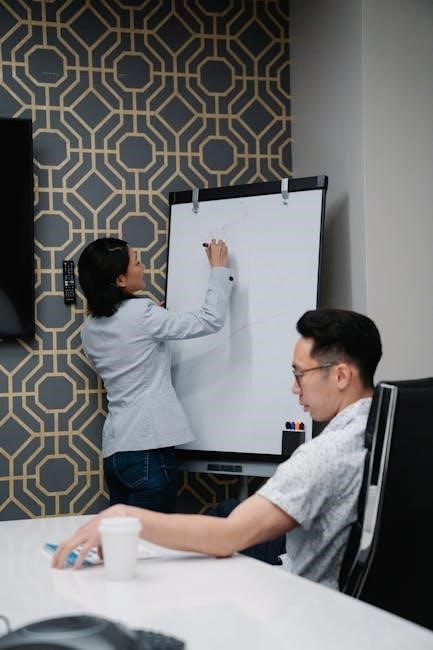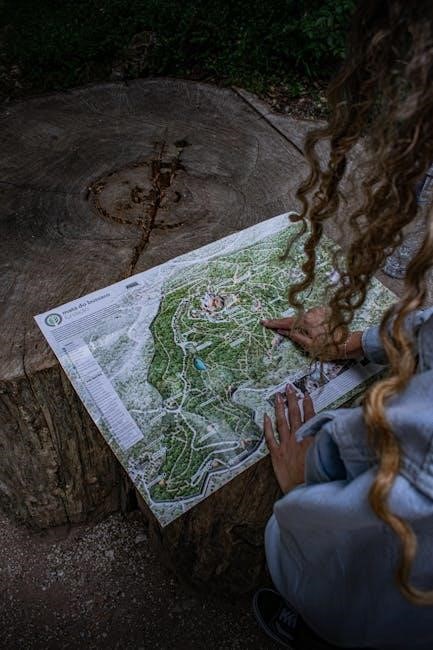Team Writing is a guide to collaborating effectively in groups, emphasizing written communication’s role in successful teamwork and providing strategies for managing projects and resolving conflicts.
1.1 The Role of Written Communication in Teamwork
Written communication is essential for effective teamwork, as it ensures clarity, accountability, and alignment among team members. It helps in documenting tasks, schedules, and decisions, reducing misunderstandings. Tools like project charters, task schedules, and meeting minutes serve as references, ensuring everyone stays on track; Written communication also facilitates conflict resolution by providing a record of agreements and actions. It allows teams to manage projects systematically, fostering collaboration and accountability. By leveraging written documentation, teams can address challenges proactively, ensuring transparency and equity in workload distribution. This approach not only enhances productivity but also strengthens team cohesion, making written communication a cornerstone of successful group work. It equips teams with the tools needed to navigate complex projects and achieve shared goals effectively.
1.2 Understanding the Importance of Collaboration in Group Projects
Collaboration is vital in group projects as it fosters creativity, enhances problem-solving, and distributes workload evenly. When team members collaborate effectively, they bring diverse perspectives, leading to innovative solutions. Collaboration also promotes accountability, as individuals are more committed to shared goals. Effective teamwork ensures that responsibilities are divided fairly, reducing the risk of overload on any single person. Moreover, collaboration strengthens interpersonal skills, such as communication and conflict resolution, which are essential for long-term success. By working together, teams can achieve outcomes that surpass individual efforts. Collaboration also helps build trust and camaraderie, creating a positive environment for productive work. Ultimately, understanding the importance of collaboration is key to harnessing the full potential of group projects and ensuring their successful completion.
Understanding Group Dynamics
Group dynamics involve understanding how teams form, develop, and function. This includes recognizing roles, managing conflicts, and ensuring equity among members to foster a productive and collaborative environment.
2.1 The Stages of Group Formation and Development
Group formation and development follow distinct stages, beginning with the forming phase, where members meet and establish goals. The storming phase introduces conflicts as personalities clash. Norming brings cohesion as roles clarify and trust builds. Performing is the productive stage where collaboration peaks. Finally, adjourning marks the project’s conclusion, with reflection on successes and areas for improvement. Understanding these stages helps teams navigate transitions smoothly, fostering effective communication and collaboration. Each phase requires adaptability and openness to ensure the group evolves into a high-performing unit capable of achieving its objectives. Recognizing these stages is crucial for addressing challenges and leveraging opportunities for growth, ultimately enhancing teamwork and project outcomes.

2.2 Identifying Roles and Responsibilities Within a Team
Defining clear roles and responsibilities is essential for effective teamwork, ensuring accountability and preventing overlaps or gaps in effort. Common roles include project manager, researcher, writer, editor, and presenter. Each role should align with individual strengths and expertise to maximize productivity. Written documentation, such as task schedules and project charters, helps clarify expectations and responsibilities. Establishing these roles early fosters a structured workflow, enabling team members to focus on their specific tasks while contributing to the collective goal. Open communication and mutual understanding of roles are critical to avoiding confusion and ensuring seamless collaboration. By assigning responsibilities thoughtfully, teams can achieve a balanced distribution of work and maintain momentum throughout the project.
2.3 Managing Conflict and Equity in Teamwork
Conflict and equity issues often arise in team projects due to differing opinions, unequal contributions, or perceived unfairness. Addressing these challenges is crucial for maintaining harmony and productivity. Teams should establish open communication channels to discuss disagreements openly and respectfully. Active listening and empathy can help resolve conflicts amicably. Ensuring equity involves recognizing individual contributions and distributing workload fairly, which can be achieved through written documentation like task schedules and meeting minutes. Team leaders should foster an inclusive environment where everyone feels valued and heard. By addressing conflicts promptly and promoting equity, teams can build trust and strengthen collaboration, ultimately leading to more successful outcomes. Regular feedback and transparent decision-making processes also help mitigate potential issues before they escalate.

Strategies for Effective Collaboration
Effective collaboration in team writing involves clear communication, defined roles, and structured documentation to ensure all members work cohesively towards shared goals and produce a successful final project together.
3.1 Setting Clear Goals and Expectations
Setting clear goals and expectations is essential for successful team writing projects. By defining objectives and roles, teams ensure everyone understands their responsibilities, fostering accountability and alignment. Establishing measurable milestones helps track progress, while transparent expectations prevent misunderstandings. Regular check-ins and open communication further support these goals, ensuring the project stays on course. This structured approach minimizes conflicts and enhances collaboration, allowing teams to produce cohesive and high-quality work collectively. Clear goals and expectations form the foundation of effective teamwork, guiding members toward a shared vision and successful outcomes in their collaborative efforts.
3.2 Using Written Documentation to Manage Projects
Written documentation is a cornerstone of effective project management in team writing. Creating task schedules, project charters, and meeting minutes ensures clarity and accountability. These documents outline roles, timelines, and deliverables, helping teams stay organized. Regular updates and shared access to these materials promote transparency and alignment. Written records also serve as references for tracking progress and resolving disputes. By maintaining detailed documentation, teams can ensure consistency and maintain focus on shared goals. This approach fosters a structured environment, enabling members to collaborate efficiently and produce high-quality outcomes. Proper documentation is vital for guiding teams through complex projects and ensuring successful completion.
3.3 Enhancing Communication Through Regular Meetings
Regular meetings are essential for maintaining clear communication within a team, ensuring all members align on project goals and progress. Both in-person and virtual meetings provide platforms for discussing ideas, addressing challenges, and assigning tasks. Consistent communication fosters collaboration and reduces misunderstandings. By setting agendas and encouraging active participation, teams can maximize meeting efficiency. Regular updates and feedback sessions help maintain momentum and ensure accountability. Open dialogue during meetings strengthens team cohesion and problem-solving abilities. Documenting key points and action items post-meeting ensures everyone is informed and on track. Regular communication checks prevent delays and keep the project moving smoothly. Effective meeting practices are crucial for achieving successful team outcomes in collaborative writing projects;
Tools and Techniques for Team Writing

Effective team writing relies on tools like task schedules, project charters, and meeting minutes to organize and document progress, ensuring clear communication and accountability throughout the collaboration process.

4.1 Creating Task Schedules and Project Charters
Task schedules and project charters are essential tools for organizing team writing projects. A task schedule outlines timelines and responsibilities, ensuring accountability and progress tracking. It helps break down complex projects into manageable tasks, allowing team members to focus on their specific roles. Project charters, on the other hand, define the scope, objectives, and deliverables, providing a clear roadmap for the team. By creating these documents, teams can establish a shared understanding of expectations and deadlines, which fosters collaboration and minimizes miscommunication. Both tools are critical for maintaining structure and ensuring that all members are aligned toward achieving the project’s goals effectively.
4.2 Documenting Progress with Meeting Minutes
Documenting progress through meeting minutes is a crucial aspect of effective team writing. Minutes serve as a record of discussions, decisions, and action items, ensuring clarity and accountability. They help teams track progress, identify tasks completed, and outline remaining responsibilities. By maintaining detailed minutes, teams can avoid miscommunication and ensure that all members are aligned with project goals. Minutes also provide a reference point for future meetings and help in reviewing past decisions. Regularly updating and sharing meeting minutes fosters transparency and keeps the team informed, making it easier to stay on track and adapt to changes. This practice is essential for managing collaborative projects efficiently and ensuring that all contributions are acknowledged and documented.
4.3 Leveraging Technology for Collaborative Writing
Technology plays a vital role in enhancing collaborative writing by providing tools that facilitate real-time editing, feedback, and version control. Platforms like Google Docs and Microsoft Teams enable teams to work simultaneously on a single document, promoting transparency and efficiency. These tools also offer features such as comment sections and change tracking, which help maintain clarity and accountability. Additionally, cloud-based solutions allow team members to access and contribute to documents from any location, making remote collaboration seamless. By integrating technology into the writing process, teams can streamline communication, reduce errors, and produce cohesive, high-quality outputs. These digital tools not only enhance productivity but also foster a collaborative environment where ideas can flow freely and effectively. This modern approach to team writing ensures that all voices are heard and valued, leading to successful project outcomes.

Addressing Common Challenges
Identifying and overcoming obstacles like procrastination, conflicts, and communication gaps is crucial for successful team writing, fostering accountability and collaboration through clear strategies and tools.
5.1 Overcoming Procrastination and Ensuring Accountability
Procrastination is a common challenge in team writing, often leading to rushed outputs and uneven contributions. To address this, teams should establish clear task schedules and deadlines, ensuring each member understands their responsibilities. Regular progress check-ins and accountability mechanisms, such as shared task lists or project management tools, can help maintain focus. Encouraging open communication about challenges or delays fosters transparency and allows for timely adjustments. Assigning specific roles and tracking contributions through written documentation, like meeting minutes or task logs, promotes fairness and accountability. Balancing flexibility with structure ensures that team members stay motivated and committed to the project’s success. By addressing procrastination early and maintaining consistent oversight, teams can deliver high-quality results and strengthen their collaborative dynamic.
5.2 Resolving Conflicts and Improving Team Cohesion
Conflicts are natural in team writing, but if left unaddressed, they can undermine progress and cohesion. To resolve disputes effectively, teams should encourage open dialogue, fostering an environment where all members feel heard. Active listening and empathy are crucial in understanding differing perspectives. Structured approaches, such as mediation or collaborative problem-solving, can help navigate disagreements constructively. Leveraging written communication tools, like agendas or meeting minutes, ensures clarity and tracks agreements. Teams should also establish clear expectations for behavior and decision-making processes to minimize friction. By addressing conflicts promptly and fostering a culture of respect, teams can enhance trust and collaboration, ultimately strengthening their ability to work together seamlessly on writing projects and delivering cohesive outcomes.
5.3 Handling Feedback and Revisions in Group Work
Handling feedback and revisions is critical for refining group work and ensuring a polished final product. Teams should establish clear communication channels to share and incorporate feedback effectively. Constructive criticism, when delivered respectfully, fosters improvement without discouraging members. Documenting feedback in writing, such as through comment logs or revision notes, provides clarity and accountability. Regular reviews of drafts, supported by written summaries, help track progress and maintain alignment with project goals. Teams should also adopt iterative revision processes, allowing for multiple rounds of refinement. By embracing feedback as a collaborative tool, teams can enhance the quality of their work and strengthen their collective output, ensuring that revisions lead to a cohesive and impactful final document.

Best Practices for Successful Team Writing

Encourage open communication, foster inclusivity, and use written documentation to maintain clarity and accountability, ensuring all team members contribute effectively and stay aligned with shared goals.
6.1 Encouraging Open and Consistent Communication
Open and consistent communication is vital for successful team writing. Regular meetings, both virtual and in-person, ensure everyone stays informed and aligned. Encouraging team members to share ideas freely fosters collaboration and creativity. Active listening and clear articulation of thoughts prevent misunderstandings. Using written documentation, such as meeting minutes and task schedules, helps maintain transparency and accountability. Establishing a feedback loop allows team members to address concerns promptly. By creating a safe and inclusive environment, teams can collaborate effectively, ensuring all voices are heard and valued. Consistent communication strengthens trust and cohesion, leading to more cohesive and polished final products.
6.2 Fostering a Positive and Inclusive Team Environment
Fostering a positive and inclusive team environment is crucial for successful collaboration. A respectful and supportive atmosphere encourages creativity and productivity. Team members should feel valued for their contributions, and diverse perspectives should be embraced. Open communication and empathy help build trust and cohesion. Recognizing individual strengths and addressing challenges collectively strengthens the team. Promoting a sense of belonging ensures everyone is invested in shared goals. Regular feedback and encouragement motivate team members to perform at their best. By cultivating inclusivity, teams can harness diverse ideas, leading to innovative solutions and a successful project outcome. A positive environment not only enhances collaboration but also fosters personal and professional growth within the team.
6.3 Celebrating Achievements and Learning from Mistakes
Celebrating achievements and learning from mistakes are essential for fostering growth and resilience in team writing projects. Recognizing accomplishments boosts morale and reinforces positive behaviors. Teams should acknowledge individual and collective successes, no matter how small, to encourage motivation and collaboration. Mistakes, on the other hand, provide valuable learning opportunities. Constructive feedback and open discussions about errors help teams identify areas for improvement. Documenting lessons learned ensures that insights are retained for future projects. By embracing a growth mindset, teams can transform setbacks into stepping stones for success. Celebrating achievements and learning from mistakes not only strengthens the team dynamic but also enhances the overall quality of the final product. This balanced approach promotes accountability, creativity, and continuous improvement in collaborative writing endeavors.



